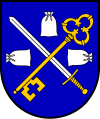
Alternate names: Pieniężno [Pol], Mehlsack [Ger], Melzak. 54°14' N 20°08' E, 141.1 miles NNW of Warszawa. This town and seat of the Pieniezno gmaina on the Wałsza River in Braniewo Powait iin Warmian-Masurian Voivodeship had a 2004 population of 2,975. The German name of Mehlsack was linguistically corrupted by German settlers to Mehlsack meaning "flour sack", and then by Poles to Melzak. In 1945, the town including its castle was 90% destroyed by WWII fighting. Apart from the town of Pieniężno, Gmina Pieniężno contains the villages and settlements of Białczyn, Bornity, Borowiec, Brzostki, Cieszęta, Gajle, Gaudyny, Glądy, Glebiska, Jesionowo, Jeziorko, Kajnity, Kierpajny Małe, Kierpajny Wielkie, Kiersiny, Kolonia, Kowale, Łajsy, Lechowo, Łoźnik, Lubianka, Niedbałki, Pajtuny, Pakosze, Pawły, Pełty, Pieniężno Drugie, Pieniężno Pierwsze, Piotrowiec, Pluty, Posady, Radziejewo, Różaniec, Sawity, Wojnity, Wopy, Wyrębiska and Żugienie.
US Commission No. POCE000765
Alternate name: Mehlsak in German. Pieniezno located at 20º08 and 54º14 E, in Elblag, 94 km E of Gdansk. The old cemetery is located at "Pizy saosie do wsi Parleosze, za pizejazdem kolejowgm." Present town population is 1,000-5,000 with no Jews.
- Local: Urzad Miasta i Gminy ul Seneralska 8; tel. 60 36. Also Urzad, Wojewodzlu w. Elblagu, ul. Wojska Polskiego 1, tel. 27001.
- Regional: Panstwowa Sluzba Ochrony Zabytkow, Elblag, ul Wojska Polskiego 1, tel. 24553.
The earliest known Jewish community was after 1772. In 1937, 5 Jewish families lived here. The unlandmarked Orthodox and Progressive/Reform cemetery probably was established mid-19th century. There was a "Judenedikt in 1812. The isolated suburban flat land and hillside has no sign or marker. Reached by turning directly off a public road, access is open to all with a broken fence without gate. The approximate size before WWII and then was.20 ha. (Now, does not exist.) No stones are visible. There are no known mass graves or structures. The municipality owns the property used for recreation. Adjacent property is recreational. The cemetery is liquidated; there is now a stadium. It was vandalized prior and during World War II, but not in the last ten years. No maintenance.
Wiktor Knercer; 10-685 Olsztyn, ul Baicza 33/16, tel. 33-86-07, completed survey 9/1992 after a visit in June 1992. He used a 1920 map and Deutsches Staedebuch, by Erich Renser 1939. and A. Sommerfeld-Juden im Armland.
